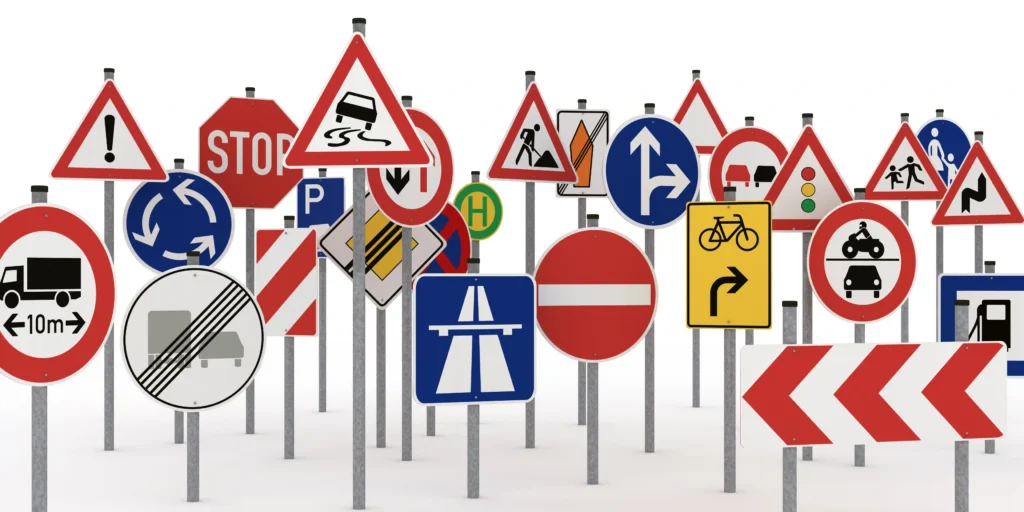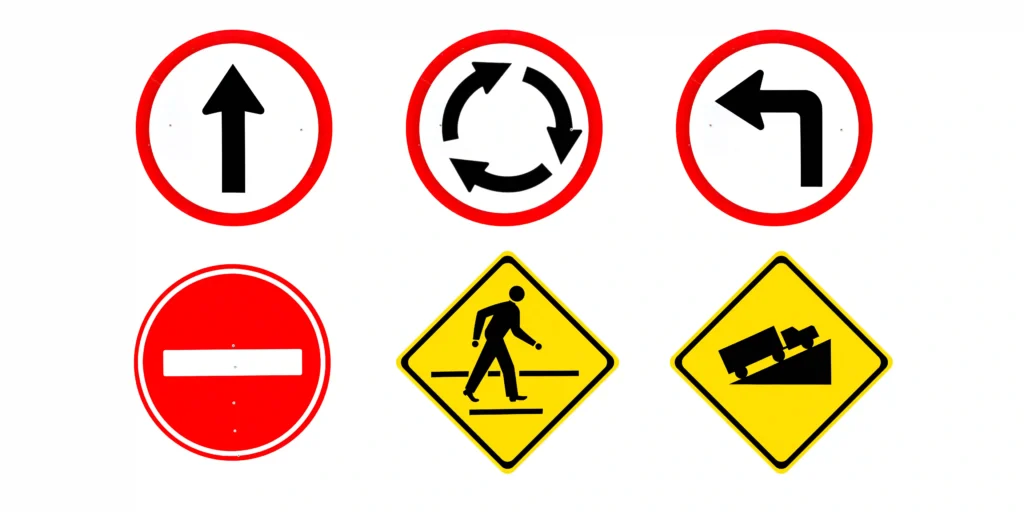How Accurate Traffic Signage Design Improves Road Safety and Flow in the UK

In the realm of highway engineering and urban infrastructure, traffic signage design plays a critical role in ensuring road safety and maintaining efficient traffic flow. For civil engineers, contractors, and highway design professionals, understanding the intricacies of traffic signage standards and how they impact road user behaviour is essential.
At ProtoTech Solutions, we are currently working on UK-based roadway design and drafting projects. Our client feedback and experience have shown us how accurate traffic signage improves public safety and traffic flow in the UK, and why it is essential to follow government rules and regulations when designing highways. In the UK, where road networks are dense and vehicle usage is high, the precision of signage design can significantly influence accident rates, journey times, and overall driver experience.
Traffic Signs

Traffic signs serve various purposes, including giving orders, providing warnings, offering directions, conveying information, and indicating road works. While The Highway Code features many commonly used signs, a detailed explanation of the government’s signing system can be found in the Department’s booklet, “Know Your Traffic Signs.” In Great Britain, road traffic signage encompasses the signing system, regulatory signs, speed limit signs, and other types of signs.
It is important to note that the signs illustrated in The Highway Code are not all depicted to the same scale. In Wales, some signs are available in bilingual versions, including both Welsh and English for place names. Additionally, some older designs of signs may still be seen on the roads. For more information, you can download the ‘Traffic Signs’ booklet.
The Importance of Accurate Traffic Signage

Accurate traffic signage serves as the silent communicator between traffic authorities and road users. Properly designed signs offer clear, concise, and timely information, helping drivers make safe decisions with confidence. When signage is inconsistent, poorly positioned, or ambiguous, it can cause confusion, hesitation, and ultimately, accidents.
In the UK, The Traffic Signs Regulations and General Directions (TSRGD) set out the standards for traffic sign design, placement, and maintenance. Compliance with the TSRGD ensures that signage meets legal requirements and maintains a uniform appearance nationwide. For engineering professionals, aligning with these regulations is not just a matter of compliance but a cornerstone of road safety design.
Enhancing Road Safety through Sign Clarity
Clarity is paramount in traffic sign design. Legibility from a distance, intuitive symbol use, and effective lighting and reflectivity all contribute to a sign’s clarity. High-speed roads, such as motorways, require larger signs with simple messages to allow drivers to comprehend information without distraction.
Recent studies by the Department for Transport (DfT) highlight that poorly designed or obscured signs are linked to an increase in road accidents. For example, inadequate advance warning signs at junctions can lead to last-minute lane changes or braking, both of which increase collision risks. By contrast, clear, well-placed signage supports proactive driving and smoother transitions between road segments.
Improving Traffic Flow with Strategic Signage Placement
Beyond safety, accurate signage directly contributes to efficient traffic flow. Strategic placement and timing of information reduce driver indecision and congestion. For example, clear directional signs well ahead of exits and roundabouts enable smoother lane discipline and reduce bottlenecks.
Smart signage, integrated with real-time traffic management systems, is increasingly used to manage congestion dynamically. Variable message signs (VMS) on UK motorways inform drivers of delays, speed limits, and lane closures. These tools empower drivers to adjust their routes or speeds pre-emptively, enhancing overall network efficiency.
Design Considerations for Engineering Professionals

For contractors and civil engineers, several design considerations are crucial when planning signage:
- Visibility and Legibility: Consider line-of-sight, font size, and environmental lighting conditions.
- Sign Placement: Position signs for optimal driver response time, avoiding visual clutter or hidden placements.
- Durability and Maintenance: Use materials that withstand weather conditions and vandalism, with planned maintenance schedules.
- Consistency with TSRGD: Adherence to national standards ensures legal compliance and driver familiarity.
- User-Centric Design: Factor in all types of road users, including cyclists, pedestrians, and HGV drivers.
- Regulatory Alignment: Follow the Design Manual for Roads and Bridges (DMRB), particularly documents such as GG 101 (Introduction to the DMRB), TD 25/01 (Inspection and Maintenance of Traffic Signs), and TD 50/04 (The Geometric Design of Roundabouts). These documents guide design decisions in conjunction with TSRGD.
- Design Speed and Context: Ensure signage aligns with the designated speed environment and road classification. Consideration should also be given to the Manual for Streets (MfS) for urban and residential contexts.
Technology and Innovation in Traffic Signage
Emerging technologies are reshaping how signage interacts with both human drivers and autonomous vehicles. Innovations such as digital road signs, augmented reality HUDs (heads-up displays), and smart sensors can enhance both safety and traffic flow.
In the UK, trials of connected vehicle infrastructure are already underway, enabling vehicles to receive live signage information digitally. This development supports future-proof road design and underscores the need for engineers to consider digital integration in signage planning.
Accurate traffic signage design is a vital component of road safety and traffic efficiency in the UK. For civil engineers, contractors, and highway design professionals, prioritising clarity, strategic placement, and regulatory compliance ensures better outcomes for all road users. As technology evolves, integrating smart signage and digital communication systems will become increasingly important, shaping the future of UK road networks. Investing in accurate signage today lays the foundation for safer, smarter, and more efficient roads tomorrow.
How Roadway Drafting Supports Accurate Traffic Signage Design

Roadway design and drafting services play a foundational role in the successful implementation of accurate traffic signage. These processes ensure that signage placement, orientation, and integration with existing infrastructure are precisely planned and executed.
- Topographical Accuracy: Drafting detailed topographical maps allows engineers to understand terrain, elevation, and road curvature. This is critical when placing signs to ensure maximum visibility and minimal obstruction.
- Site-Specific Planning: Roadway design involves assessing specific characteristics of the location, such as roadside furniture, existing utilities, and landscaping. Proper planning avoids conflicts with existing infrastructure and enhances the visibility and longevity of signage.
- Compliance Mapping: Drafting tools help align designs with regulatory requirements, such as those set by TSRGD and DMRB. This ensures the signage conforms to legal standards and is positioned for optimal driver recognition.
- Integration with Digital Systems: Modern drafting integrates with BIM (Building Information Modelling) and GIS (Geographic Information Systems), allowing signage data to be embedded into broader transport infrastructure models. This promotes smarter planning and efficient coordination among project stakeholders.
- Design Efficiency and Revision Control: Accurate drafting enables swift design iterations and better version control. This reduces errors during construction and ensures the final signage installation reflects the approved plans.
If you are looking for a trusted partner for your civil engineering project, connect with ProtoTech Solutions, delivering perfect solutions for your civil project with assurance that all local and international standards are met. Share Your Requirements






